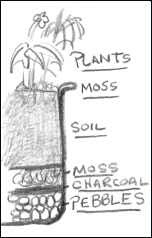REDUCE, RECYCLE, REUSE
Statistics About Plastic Bottles Harmful Effects
According to the Earth Policy Institute: Food and Agriculture, in 1976 Americans drank nearly 1.6 gallons/person of bottled water throughout a year. Now, years 37 later this number has increased to 30 gallons/person. Bottled water can cost anywhere from 240 to 10,000 times more than tap water.
Bottled water also requires millions of barrels of oil per year and added the added negative effects of large scale transportation releases thousands of tons of carbon dioxide. Not to mention the profit it's giving to manipulative Oil Companies that hit you hard at the pump!
Recycling rates for bottled water is low with only about 13 percent being converted into other products like fleece clothing, carpeting, decking, playground equipment and new containers and bottles.
According to the National Resources Defense Council over 2 million tons of water bottles ended up in U.S. landfills in 2005. That was 8 years ago and to date the number has continued to grow.
Plastic bottles can take hundreds of years to be broken down. When they are incinerated various toxic byproducts (e.g. gas chlorine gas and ash containing heavy metals) are released into the atmosphere. This contributes to toxic rain and taints freshwater supplies.
What Can College Students Do?
To begin with, you can start by simply reducing the amount of plastic products and bottles you use. The easiest way to do this is to buy a reusable water bottle. Investing in one bottle will save you nearly $5.00 each time you don't buy a case of water.
The next thing to do is recycle what you have. Some states offer cash returns for recycled goods. Take advantage of this extra source of easy money to help with college expenses.
Now For The Fun Part, REUSE
If for some reason you find that you have collected a couple of empty bottles consider turning them in creative containers for plants to decorate your room. Design anything you want to add flare to you room or any living space.
Try a Soda Bottle Terrarium for starters!
Materials
 |
| Indoor Plants- Terrarium |
- One 2-liter bottle of soda (with cap)
- Potting Soil
- moss*
- charcoal*
- A handful of small stones or pebbles
- A Marker
- Scissors
- Seeds or seedlings
(*optional)
Step 1: Draw a line around the bottle about six inches up and cut the bottle along the line.
Step 2: Place a cup full of pebbles about 1-2 inches deep in the bottom section of the bottle.
Step 3: Place the other materials in the bottle in the following order:
charcoal > moss > soil
If you are just using soil fill to 1 inch from the top.
Step 4: Plant 6 to 10 seeds and as they grow remove the weak ones. You can leave the 2 or 3 best ones.
Water your terrarium before placing the top on until the soil is moist but not saturated.
 |
| Recycled Plastic Terrarium |
Step 5: Place on the top and give yourself a pat on the back!
Taking Care of Your Soda Bottle Terrarium
When it comes to your terrarium pay attention to these two important factors:
- the amount of sunlight it gets
- the amount of water that is inside.
For watering look at the soil in the terrarium. It only needs to be moist but not soaked or dry. Water should evaporate to form beads inside near the top edge. These condensation will drip down the sides and help maintain water saturation in the soil. If it get too wet take the top off and leave it open for a day or two.
Do you have a project, story, or idea you’d like to share with us? Hit us up on social media or contact Phillip Stringer at info@collegegogreen.org
Twitter: @CollegeGoGreen
Facebook: College Go Green

Fabulous tips and I love the terrarium idea! I'm so glad that you started off with reduce because that's really the key. Unfortunately, recycled water bottles aren't really recycled ... at best they are upcycled into different products. While that's better than tossing them into a landfill, it still means that virgin materials are used to create new water bottles. So reducing the demand for them is important. And, as you've pointed out, reusable bottles can save a lot of money. Thanks so much for the post!
ReplyDeleteWow great insight, I never considered upcycling so you're right the best ecological approach would be to reduce.
ReplyDeleteWhat is the reason for adding charcoal? Since charcoal is used to absorb poisons it will also absorb vital minerals that are in the soil thereby making the soil mineral deficient. As a avid Gardener I would suggest not adding activated charcoal to this project. Please let me know if I am incorrect or mistaken. Thanks
ReplyDelete